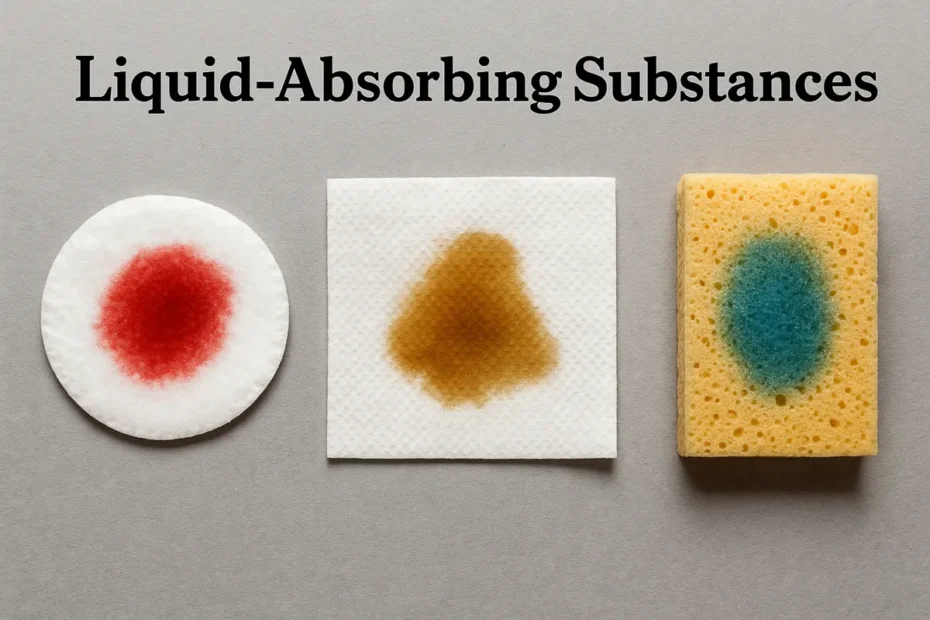The phrase liquid-absorbing substances NYT is well-known among crossword enthusiasts, but its meaning stretches far beyond puzzles. These substances play a critical role in households, medical facilities, industries, and environmental protection. In this article, we’ll explore what the term means, how these substances work, their applications, and future developments.
What Does “Liquid-Absorbing Substances NYT” Mean?
When people search for liquid-absorbing substances NYT, they are often looking for answers to crossword clues regarding materials that can soak up or retain liquids. These could include sponges, desiccants, sorbents, and absorbent fabrics. While commonly associated with puzzles, these materials are essential in real life for handling moisture and spills efficiently.
How Do Liquid-Absorbing Substances Work?
To understand liquid-absorbing substances NYT, it is important to know the two key processes involved:
-
Absorption: Liquid is drawn inside the material, like when a sponge soaks up water.
-
Adsorption: Liquid molecules cling to a material’s surface, such as moisture on silica gel.
The efficiency of these substances depends on factors like porosity, surface area, and chemical structure.
Common Examples of Liquid-Absorbing Substances
Here are some examples often associated with the phrase liquid-absorbing substances NYT:
1. Sponges
Sponges are porous materials capable of absorbing high amounts of liquid. They are commonly used in kitchens and cleaning tasks.
2. Silica Gel
Used to control moisture, silica gel works through adsorption rather than absorption.
3. Paper Towels and Tissues
These everyday items are designed to soak up spills quickly and are practical examples of liquid-absorbing substances NYT.
4. Cotton and Fabric
Cotton fibers naturally attract and absorb moisture, making them ideal for towels, clothing, and bandages.
5. Clay and Bentonite
These are used in products like cat litter for their ability to absorb liquid and neutralize odor.
6. Diapers and Superabsorbent Polymers
Modern diapers use superabsorbent polymers such as sodium polyacrylate, capable of holding hundreds of times their weight in liquid.
Industrial Applications
Liquid-absorbing substances NYT are essential across various industries, contributing to safety and cleanliness:
-
Oil and Chemical Spill Control: Absorbent pads and materials help clean hazardous spills and prevent contamination.
-
Hospitals and Laboratories: Medical gauze, absorbent mats, and spill-control products ensure hygiene and safety.
-
Manufacturing Facilities: Industrial absorbents protect workers and equipment by controlling leaks and spills.
Environmental Importance
The environmental role of liquid-absorbing substances NYT is significant:
-
Oil Spill Cleanup: Natural absorbents and biodegradable materials help remove oil from water bodies without causing further harm.
-
Agricultural Use: Water-absorbing polymers retain soil moisture, reducing irrigation needs in drought-prone areas.
However, some absorbent products made from synthetic materials contribute to pollution. This has encouraged the development of eco-friendly alternatives.
Why It Appears in Crossword Puzzles
The keyword liquid-absorbing substances NYT often appears in crossword puzzles due to its descriptive nature. It hints at words like:
-
Sponges
-
Sorbents
-
Desiccants
-
Absorbers
-
Towels
These terms fit seamlessly into crossword grids and challenge solvers with practical yet scientific vocabulary.
Future Innovations in Absorbent Materials
The world of liquid-absorbing substances NYT is evolving with new technologies and sustainable solutions:
-
Eco-Friendly Absorbents: Plant-based materials like bamboo, coconut fibers, and biodegradable polymers are becoming more common.
-
Smart Absorbent Materials: These advanced materials change color when saturated or release liquid under certain conditions.
-
Biodegradable Hygiene Products: Environmentally friendly diapers and sanitary products are being developed to reduce landfill waste.
Final Thoughts
The phrase liquid-absorbing substances NYT may begin as a crossword clue, but it represents much more in the real world. From household uses to industrial applications and environmental protection, these substances are a crucial part of modern life. Understanding their functions and uses not only helps you solve puzzles but also deepens your appreciation of science and innovation.
FAQs
1. What does “liquid-absorbing substances nyt” mean in crosswords?
It is a crossword clue pointing to materials like sponges, sorbents, or desiccants used to soak or hold liquids.
2. What are common examples of liquid-absorbing substances?
Sponges, paper towels, silica gel, clay, cotton, and superabsorbent polymers.
3. Which industries use liquid-absorbing substances?
They are widely used in healthcare, oil spill cleanup, manufacturing, and laboratories.
4. Are all liquid-absorbing substances eco-friendly?
No, some are synthetic and non-biodegradable, but eco-friendly versions made from plant-based fibers are becoming more popular.
5. Why are superabsorbent polymers used in diapers?
Because they can absorb and retain many times their weight in liquid, keeping the surface dry and comfortable.
